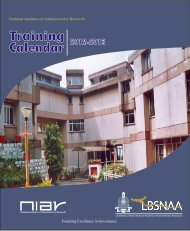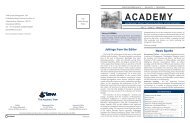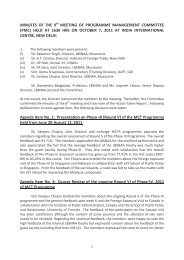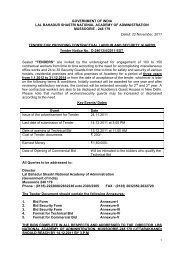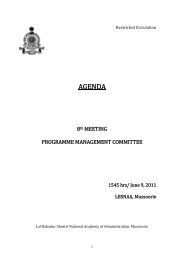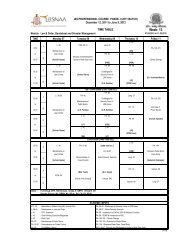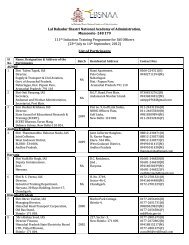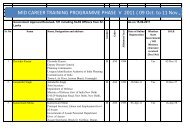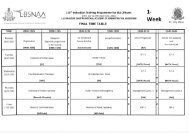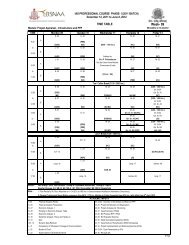Free Download - lbsnaa
Free Download - lbsnaa
Free Download - lbsnaa
You also want an ePaper? Increase the reach of your titles
YUMPU automatically turns print PDFs into web optimized ePapers that Google loves.
10 The Academy Oct.-Nov. 2008 11 The Academy Oct.-Nov. 2008<br />
monkeys near the faculty and OT residences. The<br />
health prospects for humans of these technologies is<br />
under study since what is scary for monkeys cannot<br />
be totally beneficial for humans, them being 99.5%<br />
genetically related to us. (Aryaji corrects me that<br />
some prankster probationers are 150% related). Some<br />
faculties feel that trainees are challenging enough<br />
without any prospective ultra sound induced<br />
mutations!<br />
Seriously, the Academy is a place where we have to<br />
throw "the monkey on our back" away and come out<br />
of our comfort zones. Weightlessness to fly high is<br />
the aim, freedom in thinking and action come<br />
through freeing the binds and comfort zones of the<br />
mind. Monkeys, Jhavad and ordinary add to the<br />
challenge and remind us the fluidity of the World we<br />
inhabit. Let them be, let us be, and let us keep<br />
learning from each other.<br />
* Deputy Director, LBSNAA<br />
National Health Information Highway<br />
Dr. S. H. Khan *<br />
Researchers have joined IBM's Business Consulting<br />
Services on a pilot program with one significant<br />
healthcare group. The challenges faced by the team<br />
were formulating healthcare standards specific to<br />
India and convincing healthcare entities across the<br />
nation to integrate those standards into their business<br />
processes. The partnership formed with a large<br />
hospital chain in India will facilitate the formation of<br />
a working committee, consisting of hospitals and the<br />
IT and Health ministries, to create health data<br />
standards for the country. IBM has already deployed<br />
Clinical Document Architecture (CDA) over the data<br />
grid to demonstrate standards-driven claim data<br />
exchange. And, as the first pilot program is<br />
progressing, other programs will be rolled out to two<br />
hospitals and two insurance third-party<br />
administrators.<br />
National Health Information Highway system offers<br />
information technology to help reduce medical<br />
errors, improve efficiency, assist planning (locations<br />
of specialty hospitals or medical schools, crisis<br />
management, drug and equipment supply and<br />
budgeting etc.), and accelerate research and training<br />
(using diagnosis data to train medicos or using<br />
medical problems captured on the network to build<br />
test cases.) In 2002, India's healthcare industry<br />
contributed five percent to the Gross Domestic<br />
Product (GDP) and employed approximately four<br />
million people. By 2012, it is projected to contribute<br />
8.5 percent of the GDP. Healthcare spending in the<br />
country will double over the next 10 years with<br />
private healthcare contributing a large portion of this<br />
spending, rising from US $14.8 billion to US $33.6<br />
billion. Because the traditional system of medicine is<br />
faced with escalating healthcare costs, the state<br />
health systems desperately need to improve<br />
efficiency in how they allocate and use health<br />
resources to combat the many problems the rapidly<br />
developing country has. These problems include<br />
infant and maternal mortality rates that are still high;<br />
basic reproductive and child health services, supplies<br />
and infrastructure needs that are unmet; and<br />
universal immunization of children against all<br />
vaccine-preventable diseases has not yet been<br />
achieved. In addition, the government is striving to<br />
achieve zero-level growth of HIV/AIDS, reduce<br />
mortality from vector-and water-borne diseases by<br />
50 percent, and increase the use of public health<br />
facilities-all by 2015.<br />
Other healthcare highway capabilities include:<br />
facilitating electronic data exchange (which will<br />
automate the current manual process and reduce<br />
the time it takes to settle claims from the current<br />
four to six weeks),<br />
providing data standardization (which will allow<br />
for interoperative and collaborative networks),<br />
middleware-based (to allow flexible collaboration<br />
among multiple third-party administrators and<br />
hospitals nationwide),<br />
supporting information integration and extraction<br />
(to answer queries from the doctors and<br />
administrators),<br />
supporting hybrid client platforms and<br />
programming languages (to allow different TPAs<br />
and hospitals to be part of the network),<br />
using industry standard interfaces (so that crosstraining<br />
and re-training won't be necessary),<br />
offering security through an authorized data<br />
channel (so that only authorized personnel can<br />
access this highly confidential information), and<br />
provide auditing, which is required by the IRDA,<br />
the insurance regulatory body in India.<br />
High-tech, five-star hospitals have pushed costs skyhigh.<br />
A simple headache will warrant a CT scan to<br />
rule out a brain tumour. Doctors have used the CPA<br />
to further justify expensive and sometime<br />
unnecessary investigations and therapies. On the<br />
other hand, sophisticated equipment is available in<br />
government hospitals, but it is often not in working<br />
condition. According to the VHAI report, the<br />
government's annual public health expenditure is<br />
about Rs. 10,000 crore - a pittance compared to an<br />
estimated expenditure in the private sector of<br />
between Rs. 40,000 and Rs. 60,000 crore. Private<br />
services experience support from ruling class , who<br />
often receive free treatment-which is actually<br />
intended for the poor, and is a pre-condition for the<br />
various concessions and tax benefits that these<br />
hospitals enjoy. The entry of the corporate hospital<br />
signals an open focus on profit rather than people's<br />
needs. Private medical colleges and high-tech private<br />
hospitals are proliferating across the nation. In<br />
essence ,stakeholders in these ventures, treat medical<br />
education and healthcare as any other industry<br />
which survives on profit.<br />
* Deputy Director, LBSNAA<br />
It is Mean to ignore the Median<br />
Alok Kumar *<br />
India is an economy in transition; I would say that it<br />
is at an inflection point. The right policy mix could<br />
put it well on its way to becoming a developed<br />
country. It is the second fastest growing economy in<br />
the world, clocking up average growth rates of 8-<br />
8.5% per annum in the last 5 years. It has seen a<br />
steady increase in consumption as measured by the<br />
Real Average Monthly Per Capita Expenditure<br />
(MPCE). The Below Poverty Line [income levels less<br />
than $1 (PPP) per day] population has been<br />
decreasing at a rate of 1% per annum.<br />
That said, however, it is also clear that the number of<br />
poor at 267 million [2005] remains unacceptably<br />
large. If you also include the fact that of the<br />
remaining population, 190 million earn between $1<br />
and $1.25 a day and a further 170 million earn<br />
between $1.25 and $1.35 a day, it would be clear that<br />
a large number of people 55% to be precise-are<br />
unable to afford a dignified life. The increases in per<br />
capita income (currently $575) largely reflect the<br />
income growths of the top quintile of the population.<br />
In fact, the data on changes in per capita<br />
expenditures reveal that the increase (between 1993<br />
& 2004) in case of top quintile (richest 20% of the<br />
population) was 2.03% per annum against 0.85% for<br />
bottom quintile.<br />
It could arguably be said that a few billionaires could<br />
possibly raise the mean income; without affecting the<br />
vast majority of poor. Very recently we have seen<br />
how the voters rejected the idea of “India Shining”<br />
which focused on a very narrow base of well to do<br />
sections. What are the lessons for the policy makers?<br />
The inherent learning from the above is that public<br />
policy to be effective needs to target the median<br />
voter. From our high school mathematics, we would<br />
remember that the median voter would be that voter<br />
who would divide the population exactly into two<br />
halves (one half having income greater and the other<br />
having an income lower than the median voter). If<br />
the median voter does not gain from the policy, it<br />
may not be achieving its objective.<br />
New schemes such as NREGS, RKVY & NRHMtarget<br />
exactly the median voter but the jury is still<br />
out whether they shall be able to achieve the<br />
intended outcomes in view of the delivery systems in<br />
place. Perhaps the expenditure data published by the<br />
next “thick” round of National Sample Survey on<br />
expenditures and poverty would throw some light<br />
on the subject.<br />
Till then, however, it would be safe to say with due<br />
apologies to John Allen Paulos- that it is “Mean to<br />
Ignore the Median”<br />
* Deputy Director ( Sr.), LBSNAA



